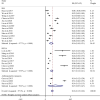Prevalence of sarcopenia in Chinese community-dwelling elderly: a systematic review
- PMID: 36076194
- PMCID: PMC9454186
- DOI: 10.1186/s12889-022-13909-z
Prevalence of sarcopenia in Chinese community-dwelling elderly: a systematic review
Abstract
Background: Sarcopenia is associated with age-related loss of muscle mass and function and is becoming prevalent in the older Chinese population. This systematic review aims to obtain a reliable estimation of the prevalence of sarcopenia among community-dwelling Chinese populations aged 65 years and older and to characterize its epidemiology.
Methods: A literature search was performed in the Cochrane Library, PubMed, Web of Science, China National Knowledge Infrastructure (CNKI), Wanfang Data, and CQVIP databases up to September 31, 2021. All studies that reported the prevalence of sarcopenia in Chinese community-dwelling older adults were included, and Hoy et al.'s tool was used to assess the risk of bias. The overall prevalence of sarcopenia will be calculated as the primary outcome, and subgroup analyses will be performed by study year, age, sex, muscle mass assessment method, diagnostic criteria and area.
Results: A total of 26 studies were included in this study, which involved 25,921 subjects, and 3597 had sarcopenia. Although significant heterogeneity between studies was reported, no statistically significant publication bias was detected. The overall prevalence of sarcopenia in community-dwelling older adults aged over 65 years in the Chinese population was 17.4% (95% CI: 14.6%-20.2%). Subgroup analysis based on study year, age and sex, muscle mass assessment method, diagnostic criteria, region and area showed that the prevalence of sarcopenia was different in each subgroup.
Implications: The prevalence of sarcopenia in Chinese community-dwelling older adults was higher than that in previous studies. As a multidimensional survey of the prevalence of sarcopenia in older adults, this meta-analysis provides data support for the targeted management of sarcopenia among Chinese older adults.
Keywords: China; Meta-analysis; Older Adults; Prevalence; Sarcopenia.
© 2022. The Author(s).
Conflict of interest statement
The authors declare that they have no competing interests.
Figures











References
-
- Bischoff-Ferrari HA, Orav JE, Kanis JA, Rizzoli R, Schlogl M, Staehelin HB, Willett WC, Dawson-Hughes B. Comparative performance of current definitions of sarcopenia against the prospective incidence of falls among community-dwelling seniors age 65 and older. Osteoporos Int. 2015;26(12):2793–2802. doi: 10.1007/s00198-015-3194-y. - DOI - PubMed
Publication types
MeSH terms
LinkOut - more resources
Full Text Sources
Research Materials
Miscellaneous

